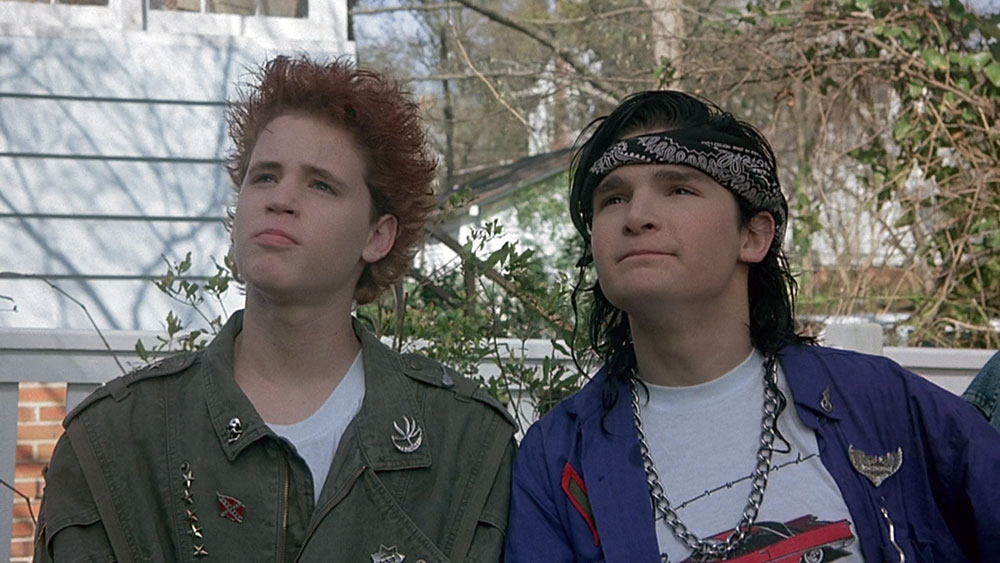The body-swap comedy enjoyed its first major wave of popularity in the late 1980s, inspired in part by the success of the original Freaky Friday (1976). Though not the first of its kind, Freaky Friday demonstrated the trope’s effectiveness as a vehicle for actors both young and old, setting the template for a focus on generational conflict. The young adult stars of the day shone in these heartwarming morality tales, from Kirk Cameron in Like Father Like Son (1987), to Judge Reinhold and Fred Savage in Vice Versa (1988), and peaking with Tom Hanks in Big (1988). But the most heart-throbbiest of the era’s teen actors took part in the trend as well: the Two Coreys, in the lesser-known dramedy Dream a Little Dream (1989).
Corey Feldman stars as high schooler Bobby Keller. Along with razzing best friend Dinger (Corey Haim), Bobby is most concerned with moussing his lengthy locks, tearing holes in his t-shirts and acid-wash jeans, and winning the affections of another friend’s girlfriend, Lainie (Meredith Salenger). In addition to smoking cigarettes and casually swigging from backpack flasks, their juvenile delinquency includes trampling the flowers in a neighbor’s yard on a popular shortcut to school. That yard belongs to Coleman and Gena, an aging couple played by legendary actors Jason Robards and Piper Laurie; in a vaguely-explained effort to enter into an eternal shared dreamstate, they are in the midst of performing a “meditation” experiment on the front lawn one night when, mere feet away, Bobby and Lainie collide on the shortcut. These simultaneous occurrences cause a dimensional rift such that Coleman ends up in Bobby’s body, Bobby and Gena are trapped in a misty world visited only via Coleman’s dreams, and Lainie holds the key to bridging the space-time gap—though she doesn’t know it. Coleman must find his way back to Gena or risk being separated from her forever, while surviving the stress and violence of Bobby’s everyday life—to which Bobby himself has no interest in returning.
Unlike the typical format of the device, this swap is not between laid-back child and uptight parent; though Coleman is a little peeved with the kids crushing his begonias, his driving obsession is with prolonging his relationship with Gena into perpetuity—much to the dismay of their friend Ike, portrayed by the always welcome Harry Dean Stanton—and has little to do with the various traumas plaguing Bobby. Yet it is Coleman’s struggle with those challenges (and Feldman’s moving portrayal thereof), from the banal indifference of Bobby’s parents to the near-lethal beatings he takes from the leather boys after school, that provides for the film’s most successful sequences. Whether we find it entirely believable that Dinger’s mother broke his leg by driving over him in a stupor, or that Lainie’s mother demands that she put out for her pushy boyfriend, the film convincingly captures the intensity of coping with adult incomprehension and the life-or-death experience of teenage drama.
The potentially deadly quality of that drama is underscored by the presence of two child actors who most poignantly represent the perilous heights and shattering depths of youthful popularity. Mark Rocco, in his second of three directorial efforts before his own untimely death, allows the camera to linger troublingly over the teenagers’ bodies, capturing their increasing awkwardness as they enter what today’s viewers know will be a wildly unforgiving adulthood for both. Seeing Feldman dress up as and mimic the then-ubiquitous dance moves of Michael Jackson throughout Dream a Little Dream only increases the vertiginous anxiety accompanying what should be a fairly lighthearted romp. The film is screening as part of Film at Lincoln Center’s tribute to Nope, the third of four Feldman features selected by Jordan Peele for his sidebar series, “The Lost Rider: A Chronicle of Hollywood Sacrifice.” Peele has discussed references to Feldman “hidden” in his previous film, Us, and recently purchased one of the prosthetic ears the actor wore while making Stand by Me (1986). The vague queasiness of watching Dream a Little Dream now, despite the film’s many charms, feels a bit like reliving one of Nope’s many themes—the dangerous spectacle of a child actor’s lingering trauma.
Dream a Little Dream screens tonight, January 10, at Film at Lincoln Center in 35mm, introduced by the actor Cory Feldman. It is part of the series “The Lost Rider: A Chronicle of Hollywood Sacrifice.”



